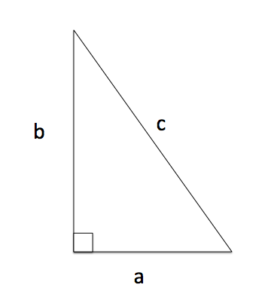Learning Outcomes
- Calculate the volume of a cone
- Calculate the volume of a sphere
- Calculate the volume of rectangular solid
- Use the Pythagorean theorem to find the unknown side length of a right triangle
- Use the distance, rate, and time formula
In the Related Rates section, we will take derivatives of various mathematical formulas. Here we will review the formulas for calculating volume of a cone, volume of a sphere, and volume of a rectangular solid. We will also briefly review the Pythagorean Theorem and the distance, rate, and time formula.
Find the Volume of a Cone
The volume of a cone can be found using the following formula:
[latex]V=\frac{1}{3}\pi r^2h[/latex]
where [latex]r[/latex] is the radius of the circular base of the cone and [latex]h[/latex] is the height of the cone.
Example: Finding the Volume of A Cone
Find the volume of a cone with height 6 inches and a base with radius 2 inches.
Try It
Find the Volume of a Sphere
The volume of a sphere can be found using the following formula:
[latex]V=\frac{4}{3}\pi r^3[/latex]
where [latex]r[/latex] is the radius.
Example: Finding the Volume of A Sphere
Find the volume of a sphere with radius 6 centimeters.
Try It
Find the Volume of a Rectangular Solid
A rectangular solid has a length, width, and height. The volume of a rectangular solid can be found using the following formula:
[latex]V=lwh[/latex]
where [latex]l[/latex] is the length, [latex]w[/latex] is the width, and [latex]h[/latex] is the height.
Example: Finding the Volume of A Rectangular solid
Find the volume of a rectangular solid with length 14 inches, height 17 inches, and width 9 inches.
Try It
Use the Pythagorean Theorem
The Pythagorean theorem is a statement about the sides of a right triangle. One of the angles of a right triangle is always equal to [latex]90[/latex] degrees. This angle is the right angle. The two sides next to the right angle are called the legs and the other side is called the hypotenuse. The hypotenuse is the side opposite the right angle, and it is always the longest side.

A right triangle with sides labeled.
The Pythagorean theorem is often used to find unknown lengths of the sides of right triangles. If the longest leg of a right triangle is labeled c, and the other two a, and b as in the image on the left, The Pythagorean Theorem states that
[latex]a^2+b^2=c^2[/latex]
Given enough information, we can solve for an unknown length.
In each of the following examples, we will use the Pythagorean theorem to find a missing side of a right triangle.
Example: Using The Pythagorean Theorem to Find The Length of the Hypotenuse
A right triangle has legs measuring 6 and 7 centimeters. Find the length of the hypotenuse.
Try It
Example: Using The Pythagorean Theorem to Find The Length of A Leg
A right triangle has a leg measuring 10 inches. The hypotenuse measures 12 inches. Find the length of the other leg.
Try It
Use the Distance, Rate, and Time Formula
For an object moving at a uniform (constant) rate, the distance, [latex]d[/latex], traveled is:
[latex]d=rt[/latex]
where [latex]r[/latex] is the rate and [latex]t[/latex] is the time.
Example: Using the Distance, Rate, and Time Formula
Jenny rides her bike at a uniform rate of 10 miles per hour for 3 hours. How far has she traveled?.
Try It
Candela Citations
- Modification and Revision . Provided by: Lumen Learning. License: CC BY: Attribution
- College Algebra Corequisite. Located at: https://courses.lumenlearning.com/waymakercollegealgebracorequisite/. License: CC BY: Attribution
- Precalculus. Provided by: Lumen Learning. Located at: https://courses.lumenlearning.com/precalculus/. License: CC BY: Attribution
